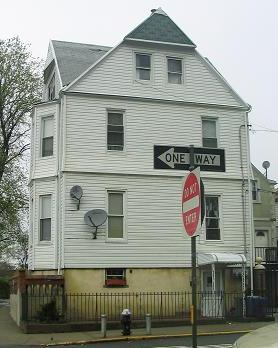After the incorporation of Long Island City there remain no incorporated villages within the limits of the town of Newtown, but there are a score of hamlets, prominent among which and noted for their prosperity, business and as places of residence for those seeking country homes near to the city, are Maspeth, Woodside, Winfield, Corona, CoIumbusville, Ridgewood and Glendale.
Maspeth, situated in the western part of the town, is located on three plots of ground on the north side of the street railroad running from Brooklyn, E. D., to Newtown village, and is about three miles distant from the Willaimsburg ferries. The map of the first plot was filed in August, 1852 by Joseph W. Van Mater, Jr. It was in Maspeth that De Witt Clinton, who became Governor of the State of New York, conceived the idea and drew his plans for connecting Lake Erie with the Hudson.
DeWitt Clinton's House
The house in which Gov. Clinton resided while living at Maspeth stands on a slight elevation on the north side, and but a short distance from the track of the Montauk Railroad, at the head of Newtown Creek, where for many years stood the town dock, still remembered by the old residents. It is a long two-story wooden building, with broad verandas running its entire length both front and rear, on the first aud second stories. It is surrounded by stately trees and is still in good repair. It is now used as a hotel and the spacious grounds surrounding It as a summer park.
At the head of Newtown Creek, on the south side of Montauk Railroad and nearly directly opposite the Clinton House, standing on high ground surrounded by a grassy lawn sloping down to the roadside, is the residence of William H. Furman.
Almost directly opposite on the east side of Maspeth avenue and running through to Grand street are the trout ponds and stone dwelling, or clubhouse owned by William H. Furman. The ponds, nearly half mile in length, are in the shape of the letter S, and are fed by boiling springs from the bottom. Owing to the heavy losses from poachers by reason of their nearness to the city, the ponds, as a trout preserve as well as for trout breeding were abandoned several years ago. They still afford fair fishing. In 1868 Mr. Furman marketed over one ton of trout from his Maspeth ponds.
Maspeth has a fine public school building and three church edifices. The Episcopalian, organized in May 1848; Methodist, organized in 1865; and the Catholic, built in 1871.
The Grand street and the Queens County baseball and picnic grounds are situated at Maspeth. The prohibiting of baseball playing and the sale of liquor or beer at the Newtown parks on Sundays will prove a heavy loss to the proprietors of the several parks and a great gain to those residing in their vicinity, who heretofore have been annoyed by the noisy crowds of men and boys who, visiting the parks on Sundays, would sometimes invade their premises and steal flowers and fruit, regardless of their protestations.
Mount Olivet Cemetery, with its main entrance on Grand street, covers sixty acres of Maspeth, all of which has been laid out and beautified. The residence of Mr. Cord Meyer, with its well-kept grounds, on Grand street, north of the Montauk Railroad, is one of the most costly in Maspeth. The principal industry of Maspeth is the oil cloth manufactory of Alden Sampson's Sons. The factory is the largest of its kind in the world. There are several factories for the manufacture of fertiizer and animal carbon, the largest being that of Mr.Cord Meyer, on Newtown Creek. The carbon is used chiefly in the filtration of sugar.
The residence of the late Hon. James Maurice, who represented Queens County in the Assembly in 1852 and the First District in Congress from 1852 to 1855, is on a portion of the Furman farm fronting on Maspeth avenue, a short distance west of the trout ponds. It Is now occupied by the deceased's brother and sisters. Prominent among the residents of Maspeth, who are well known socially and politically, may be mentioned Mr. Cord Meyer, Chairman of the State Democratic Committee; State Senator Edward F. Fagan, ex-Sheriff Garret Furman, John Van Coli, James W. Smith, Thomas Pettit and Police Justice Francis Mc Kenna.
This is an excerpt from an article in the Long Island edition of the Brooklyn Times of June 2nd 1889.



